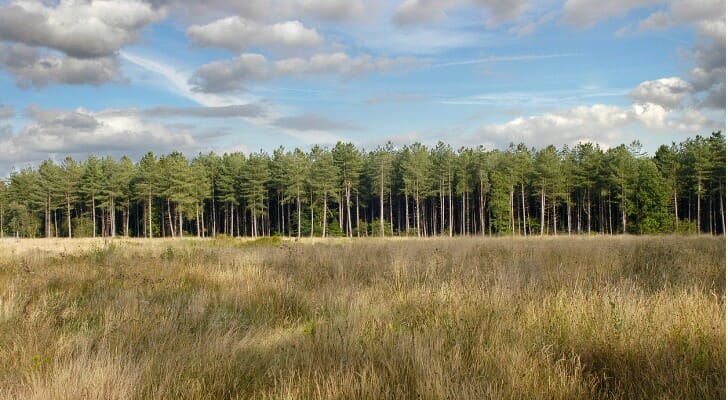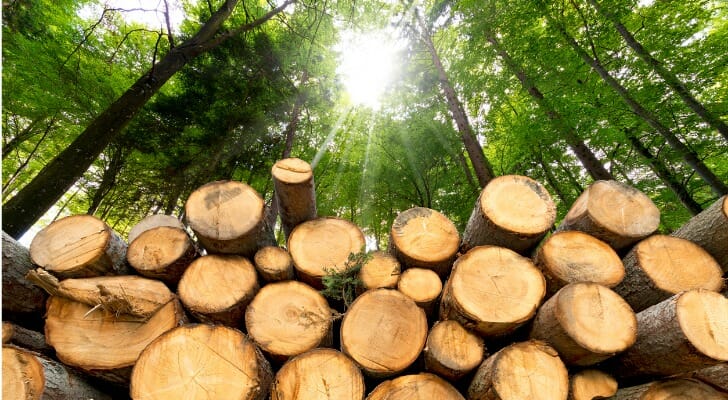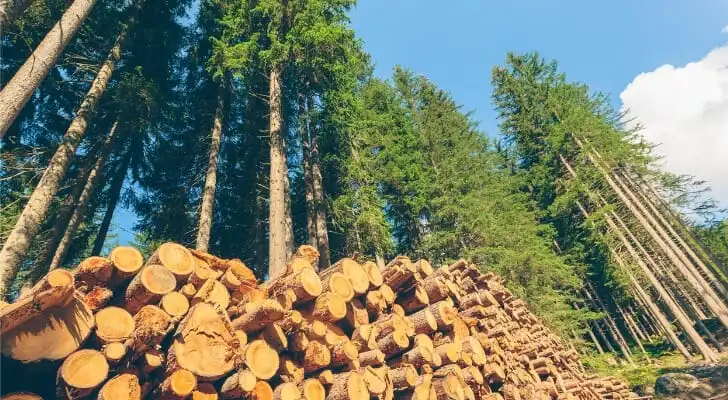Investing in forest land suitable for producing lumber can provide you income, diversification, inflation protection and more. Timber investing requires careful study of the industry, market and individual parcels, and it’s generally a long-term play, with years required to realize a profit. Timberland is also highly illiquid, so you might need a year or more to turn your asset into cash should you need it. Talk to a financial advisor to learn how investing in timber and other real assets can help you achieve your long-term objectives.
Timber Investment Basics
Investing in timber involves owning land that’s used to grow trees that can be processed into lumber. Timber, which is considered a real asset, is vital to the production of paper, utility poles and furniture, as well as the construction of homes and other buildings.
Timber sales are infrequent, as it can take decades for trees to grow large enough to be harvested. In fact, you may only make a handful of timber sales in your life as a timberland investor. Timber investors can generate income more regularly by selling seeds or renting land for livestock to graze on. Timberland can also be used for recreation.
More than 500 million acres of commercial timberland exist in the United States, according to the United States Department of Agriculture. An acre of timberland can cost from $1,500 to $2,000, with prices varying by location, road access and the type and maturity of trees. The value of timber also varies by tree variety, size and quality. According to TimberUpdate.com, which tracks prices and trends in the timber industry, prices can range from about $5 per ton for low-quality small trees to as much as nearly $50 per ton for mature, straight trees that can be sawn into knot-free boards for decorative uses.
Pros and Cons of Timber Investing

Timberland has a number of features that make it attractive to investors. These include:
- Income from selling timber to sawmills
- Inflation protection similar to other commodities
- Diversification and risk management from owning an asset not correlated to stocks, bonds and other asset classes
- Favorable capital gains tax treatment for most income
- Appreciation as trees grow into more mature specimens that command higher prices
- Sustainability, since trees generally benefit the environment
Owning timberland can also give you the opportunity to personally enjoy an investment. A section of timberland can even provide a site for building a second home or even a primary residence.
But owning timberland also may involve some or all of the following limits and risks:
- Long time frames waiting for trees to be mature enough to harvest
- Unpredictable prices when you sell trees due to commodity cycles
- Time, money and attention required to plant and tend trees and maintain the property
- Risk of fires, floods, hurricanes and other natural disasters
Low liquidity compared to most other investments can also be an issue. It can easily take a year or more to sell a parcel of timberland and turn your investment into cash.
Investing in Timber ETFs

Rather than directly buying timberland yourself, you can buy shares of exchange-traded funds (ETFs) focused on timber. These specialized ETFs invest in shares of companies that own or lease timberland and harvest the trees for lumber or other forest products. Buying shares of timber-focused ETFs allows you to get asset diversification, inflation protection and other timber investment benefits without the challenge and illiquidity of owning and managing the timberland yourself. You will also get additional diversification within the asset class because these ETFs own shares of a number of timber-related companies, reducing your exposure to weather, fire and other risks.
Timber ETFs include the iShares Global Timber & Forestry ETF and the Invesco MSCI Global Timber ETF.
Bottom Line
Timberland investments offer a way to diversify your portfolio with real assets that can produce both income and capital gains. But buying and owning timberland requires an in-depth knowledge of the industry and significant time and attention. Timberland is also a long-term play, often requiring years or decades to generate a profit.
Investing Tips
- A financial advisor can help you evaluate alternative approaches to achieving diversification, inflation protection and other benefits of owning timberland. If you don’t have a financial advisor yet, finding one doesn’t have to be hard. SmartAsset’s free tool matches you with up to three vetted financial advisors in your area, and you can have a free introductory call with your advisor matches to decide which one you feel is right for you. If you’re ready to find an advisor who can help you achieve your financial goals, get started now.
- SmartAsset’s Investment Return & Growth Calculator takes a lot of the guesswork out of forecasting how your investment will perform over time. Enter the amount of your initial investment, the timing and amount of any additional contributions, your anticipated rate of return and the number of years you plan to let the investment grow. The calculator will give you an estimate of how much your portfolio will be worth, assuming all those factors play out as planned.
Photo credit: ©iStock.com/MoreISO, ©iStock.com/anthonyjhall, ©iStock.com/catalby
